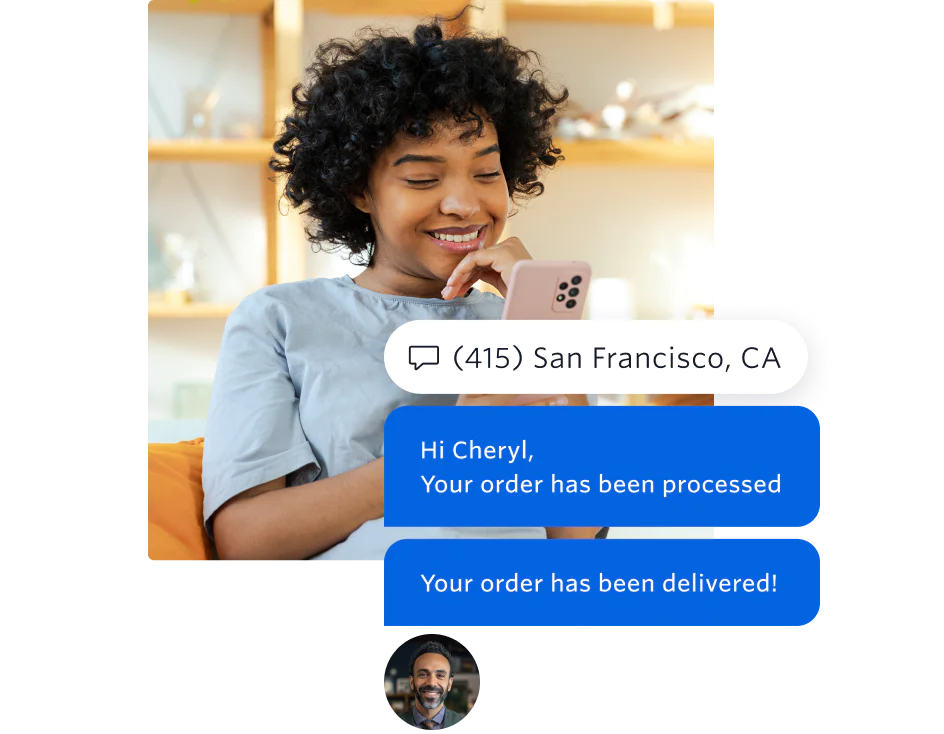What is A2P 10DLC?


Application-to-person 10-digit long code numbers (A2P 10DLC) are dedicated routes for US business messaging. They are local numbers with an area code like 415, 212, or 310 for a local messaging experience.
After completing 10DLC registration, brands can send SMS messages with increased throughput and deliverability—capturing the benefits of short codes without the cost or long time to market.
10DLC phone number use cases
10DLC features
-
High-throughput
Increased throughput up to 225 messages per second per campaign with 10DLC numbers
-
One number for messaging and voice
The same familiar local number for SMS messages or phone calls
-
Recognizable, local number
Increase open rates with a local 10-digital long code your customers recognize
-
10DLC registration
Save time on your A2P 10DLC registration with one verification process in Twilio’s Trust Hub
-
Reduced filtering
With A2P 10DLC compliance, deliver high-volume business messages over A2P routes with reduced filtering
-
API & software for onboarding
Register your 10DLC number successfully as an enterprise business or hobbyist developer
What are the benefits of A2P 10DLC numbers?
Getting started with 10DLC numbers
Join Twilio’s fully verified 10DLC ecosystem to communicate with customers on the most trusted, reliable local numbers.
Need help?
Build and register your A2P 10DLC application with Twilio Professional Services.
All your messages delivered reliably with a local A2P 10DLC number
FAQs about 10DLC
10DLC numbers have a local prefix. Toll-free numbers have a standard prefix like 888 or 833.
10DLC numbers are also a way for businesses to send over dedicated application-to-person routes for business messaging. There are restrictions and guidelines for what you can send over A2P 10DLC numbers.
Sending messages over 10DLC numbers can be less expensive than toll-free or short codes, for that matter.
While there is a verification process for both number types, the approval process for a 10DLC number can take longer to complete than toll-free number.
A sole proprietor 10DLC registration is for senders (in the US and Canada) that do not have a business Tax ID like a US EIN or a Canadian Business Number. This often applies to individuals who are sending messages or small businesses.
As a sole proprietor, you still need to complete the 10DLC registration process to let carriers know who you are and what messages you’re sending to customers.
To complete 10DLC registration, follow these three steps:
- Brand verification: Provide information about who is sending the messages.
- Campaign approval: Register what is being sent for each of your use cases and how you’ll manage customer consent.
- Submit phone numbers: Associate your 10DLC phone numbers with your Campaign by adding them to the Sender Pool of the Messaging Service associated with your Campaign.
There isn’t an exact timeline because 10DLC registration requires approval from carriers, Twilio, and external vetting partners.
We estimate that it takes under one week to get campaign approval.
The cost depends on the type of registration you’re completing.
Standard registration: $44 one-time brand registration, +$15 per campaign for a one-time campaign vetting fee, +$1.50-$10 per campaign per month.
This applies to ISVs and brands that have a business tax ID (EIN), and send over 6,000 segments per day, and need high throughput.
Low-volume standard registration: $4 one-time brand registration, +$15 per campaign for a one-time campaign vetting fee, +$1.50-$10 per campaign per month.
This applies to ISVs and brands that have a business tax ID (EIN), and send less than 6,000 segments per day, and need low throughput.
Sole proprietor: $4 one-time brand registration, +$15 per campaign for a one-time campaign vetting fee, +$2 per campaign per month.
This applies to ISVs, individuals, and small businesses that do not have a business tax ID (EIN) and send less than 1,000 messages per day (T-Mobile) on one phone number through one campaign.
Review the fees and learn more about campaign vetting or compare Low-volume standard, Standard, and Sole proprietor options.
Yes, when you register your 10DLC phone number to your brand, you register campaign use cases for your messages that say why you’re sending to customers. Your campaign use cases must first be approved.
And if you need to add new use cases for another purpose, you may need to register another campaign to stay within compliance.







